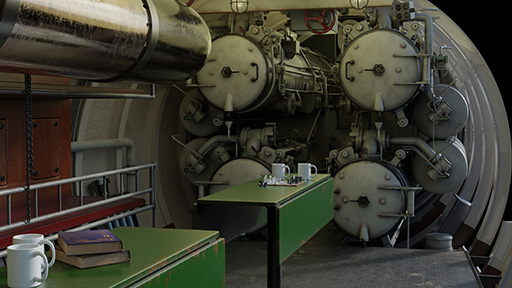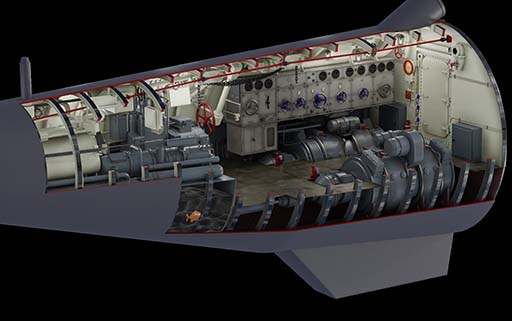Cutaway Type VII U-Boat WIP…




man you did a very good work on the design, i never thought thy were that big, ?
have you ben into one before or something ?
because it really looks detailed
I did a low poly prop for this model
but you did a higher res then mine
nice work
start adding some material cycles
should look even better
can you add in first post some of the general spec for this sub
there was also the type 9 and 21 I think
are you planning to do these too ?
keep up the good work
happy bl
I’ve never been in a Type VII before. As far as ships go, U-boats weren’t that big and living conditions were quite crowded and difficult (heat, noise, humidity, close quarters, limited sanitation…)
This is only the start of the project. I’m just roughing in where the big pieces of equipment go.
General specs for the Type VIIC:
Displacement: 719 tons (surface), 871 tons (submerged), 1070 tons (fully loaded)
Length: Casing 66.5 meters, Pressure Hull 50.5 meters
Beam: Casing 6.2 meters, Pressure Hull 4.7 meters
Draught: 4.74 meters
Engines: Germaniawerft Diesels (2800-3200 bhp)
Max surface speed: 17-17.7 knots
Range 8500 sea miles @ 10 knots
There were several versions of the Type VII boats built (704 in total). I’m building a Type VIIC
VII…10 boats
VIIB…24 boats
VIIC…660 boats
VIID…6 boats
VIIF…4 boats
Germany produced many classes of U-Boats during the war. Some made it to combat, others only served as test projects. I think the Type numbers range all the way up to the thirty’s (XXX) for some of the experimental boats.
can you describe the different parts
do I see 2 elec generators ?
what power are they ?
are these diesel gen ?
sorry I could ask 1000 questions on elec things LOL
what is the big cylinder in the back end ?
where did you get all these details ?
thanks
happy cl
Thank you for your interest in my project. Most of my research comes from books I own and Internet searches. Photos of the U-995 (which is on display at the Laboe Naval Memorial near Kiel Germany) have been particularly useful for interior details.
This section of the boat contains two electric motors (total of 750 shp) as well as a single stern torpedo tube (53.3cm G7 type torpedo). One torpedo was carried in the tube. One spare torpedo was carried in an exterior water-tight compartment above the pressure hull (not shown in my renders yet) and one reload torpedo was stored below the flooring of the compartment.
Other details…
do you have the size of these elec motors ?
very interesting
I was not able to find such data on the internet
I would suggest start to add materials now
or it will be a nightmare later on to add 1000 mat !
thanks
happy cl
found this on wiki
have to check wiki again
got the wrong sub
don’t know what the shaft diam were ?
happy bl
these motors were double acting
do you have any details how these work ?
I mean each motor was able to drive the 2 shafts ?
not certain how the gear box work for that !
how come we don’t see any elec generator
I mean the diesel would be there to feed a generator as I know of !
thanks
happy bl
I don’t have the exact size for the electric motors. I know that there were several manufacturers/models used on the Type VIIC boats: AEG GU 460/8-276, BBC (Brown Boveri & Co) GG UB 720/8, GL (Garbe Lahmeyer) RP 137/c, and SSW (Siemens-Schuckert-Werke) GU 343/38-8. All varients produced a combined 750 shp with a maximum submerged speed of 7.6 knots. The only photos I’ve been able to find of them are on the U-995, so I’m only able to accurately model the parts of the motors that are visible on the U-995.
I’ll wait until the compartment is completely modeled before I unwrap UVs and texture. My plan is to texture each compartment as I go along. There’s really a lot fewer parts than it looks. Many of the details are group instances, mirrored objects or the result of array modifiers. Pipes and wires are curves with Bevel and Resolution turned on. I’m also not planning on doing super realistic materials on many of the pieces. (I’ll use procedural textures on as much as I can.) I’m hoping this will suffice for things like pipes, fittings and other small items.
I do not know the exact diameters of the propeller shafts. I just modeled them based on profile drawings I have.
I believe each motor was only responsible for one propeller. I’m not aware of a common gear box or differential that would split power across both propellers. The drawings I have only indicate reduction gearing and clutches for each engine/motor combination.
There is an auxiliary generator in this compartment, on the port side, shown as item #2 in the above image. I’m not certain what its role is in relation to the electric motors, but its proximity to the electric motors makes me think it had something to do with the electric propulsion system.
The diesel engines are in the compartment in front of the one I’m currently modeling. They are much more powerful than the electric motors, but they require air for combustion, so they could only be used while the boat was surfaced. While running on the surface, the diesels would also recharge batteries that are stored in the lower sections of the boat. These batteries would be used to power the electric motors while the boat was submerged.
I can assure you they aren’t. A few kilometers from where I live U-995, a real Type VII C U-Boat built in 1943, is propped at the beach and can be visited from the inside.
I normally don’t tend to be claustrophobic, but in there I (6 feet and 4 inches tall) really need to pull myself together. And that’s despite knowing that there is a door sized opening in the pressure hull front and back. I don’t want to imagine what it must have been without that and with 100 meters of water above you. Not to mention the 40 to 50 other people you had to share the space with.
oh really? thats weird , i think the imgs makes it looks so big
Yeah, but take away the pressure hull, the engine and battery compartments, air and diesel tanks and torpedo storage and you’re left with a “living area” a man can hardly stand upright in, corridors just wide enough for one man to pass and bulkheads every few meters you have to crouch through. Not fun.
damn thats a grave
Don’t forget to add in: near 100% humidity, rotting food, only one shower a month, air that tastes like diesel fuel, two toilets (only one could be used for beginning of voyage because the other was used as a pantry when the ship left dock; neither could be used when the ship was deep because there wasn’t enough pressure to eject waste material), engine room temperatures around 40C, mold, engine noise - deafening, etc…
hope you can show the diesels with the generators
it looks like there is some sort of a small motor over the bigger motor
my guess is that are used as ventilator to cool off the big motor
but on wiki they are saying that these were double acting
not certain why we don’t see this !
the motor cold be operated from the main generators or the batteries
any idea at what voltage these motor were working ?
happy bl
Indeed. And it still, after all those years, smells like diesel fuel and torpedo grease in there.